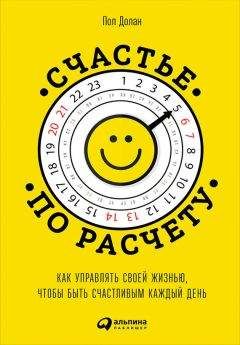Пол Долан - Счастье по расчету. Как управлять своей жизнью, чтобы быть счастливым каждый день

Помощь проекту
Счастье по расчету. Как управлять своей жизнью, чтобы быть счастливым каждый день читать книгу онлайн
154
Dolan P. Using happiness to value health. Office of Health Economics, 2011.
155
Dolan P., Loomes G., Peasgood T., Tsuchiya A. Estimating the intangible victim costs of violent crime. British Journal of Criminology 2005; 45: 958–76.
156
Dolan P., Kahneman D. Interpretations of utility and their implications for the valuation of health. Economic Journal 2008; 118: 215–34.
157
Shaw J.W., Johnson J.A., Coons S.J. US valuation of the EQ-5D health states: development and testing of the D1 valuation model. Medical Care 2005; 43: 203–20.
158
Dolan P., Metcalfe R. Valuing health: a brief report on subjective wellbeing versus preferences. Medical Decision Making 2012; 32: 578–82.
159
Menzel P., Dolan P., Richardson J., Olsen J.A. The role of adaptation to disability and disease in health state valuation: a preliminary normative analysis. Social Science & Medicine 2002; 55: 2149–58.
160
Dolan P., Kavetsos G., Tsuchiya A. Sick but satisfied: the impact of life and health satisfaction on choice between health scenarios. Journal of Health Economics 2013; 32: 708–14.
161
Смит А. Теория нравственных чувств. – М.: Республика, 1997.
162
Dolan P., Metcalfe R. “Oops… I did it again”: repeated focusing effects in reports of happiness. Journal of Economic Psychology 2010; 31: 732–37.
163
Distinction bias: misprediction and mischoice due to joint evaluation. Journal of Personality and Social Psychology 2004; 86: 680.
164
Loewenstein G., O’Donoghue T., Rabin M. Projection bias in predicting future utility. Quarterly Journal of Economics 2003; 118: 1209–48.
165
Dutton D.G., Aron A.P. Some evidence for heightened sexual attraction under conditions of high anxiety. Journal of Personality and Social Psychology 1974; 30: 510–17.
166
Simonsohn U. Weather to go to college. Economic Journal 2010; 120: 270–80.
167
Conlin M., O’Donoghue T., Vogelsang T.J. Projection bias in catalog orders. American Economic Review 2007; 97: 1217–49.
168
Read D., van Leeuwen B. Predicting hunger: the effects of appetite and delay on choice. Organizational Behavior and Human Decision Processes 1998; 76: 189–205.
169
Chochinov H.M., Tataryn D., Clinch J.J., Dudgeon D. Will to live in the terminally ill. Lancet 1999; 354: 816–19.
170
Baumeister R.F., Vohs K.D., DeWall C.N., Zhang L. How emotion shapes behavior: feedback, anticipation, and reflection, rather than direct causation. Personality and Social Psychology Review 2007; 11: 167–203.
171
Bar-Hillel M., Neter E. Why are people reluctant to exchange lottery tickets? Journal of Personality and Social Psychology 1996; 70: 17.
172
Gilbert D.T., Morewedge C.K., Risen J.L., Wilson T.D. Looking forward to looking back: the misprediction of regret. Psychological Science 2004; 15: 346–50.
173
Kahneman D., Wakker P.P., Sarin R. Back to Bentham? Explorations of experienced utility. Quarterly Journal of Economics 1997; 112: 375–406.
174
Fredrickson B.L., Kahneman D. Duration neglect in retrospective evaluations of affective episodes. Journal of Personality and Social Psychology 1993; 65: 45.
175
Wakin D. Ringing finally ended, but there’s no button to stop shame. New York Times, Jan. 12, 2012.
176
Clark A.E., Georgellis Y. Kahneman meets the quitters: peak-end behavior in the labour market. Unpublished working paper, 2004.
177
Nickerson R.S. Confirmation bias: a ubiquitous phenomenon in many guises. Review of General Psychology 1998; 2: 175.
178
Mahoney M.J. Publication prejudices: an experimental study of confirmatory bias in the peer review system. Cognitive Therapy and Research 1977; 1: 161–75.
179
Ross L. The intuitive psychologist and his shortcomings: distortions in the attribution process. Advances in Experimental Social Psychology 1977; 10: 173–220.
180
Gilbert D.T., Malone P.S. The correspondence bias. Psychological Bulletin 1995; 117: 21.
181
Ouellette J.A., Wood W. Habit and intention in everyday life: the multiple processes by which past behavior predicts future behavior. Psychological Bulletin 1998; 124: 54.
182
Webb T.L., Sheeran P. Does changing behavioral intentions engender behavior change? A meta-analysis of the experimental evidence. Psychological Bulletin 2006; 132: 249–68; Astell-Burt T., Feng X., Kolt G.S. Greener neighborhoods, slimmer people? Evidence from 246,920 Australians. International Journal of Obesity 2013.
183
Frijters P. Do individuals try to maximize general satisfaction? Journal of Economic Psychology 2000; 21: 281–304.
184
Фестингер Л. Теория когнитивного диссонанса. – М.: Ювента, 1999.
185
Festinger L., Carlsmith J.M. Cognitive consequences of forced compliance. Journal of Abnormal and Social Psychology 1959; 58: 203–10.
186
Masataka N., Perlovsky L. Music can reduce cognitive dissonance. Nature Precedings 2012; Knox R., Inkster J. Postdecision dissonance at post time. Journal of Personality and Social Psychology 1968; 8: 319–23; Foster J.D., Misra T.A. It did not mean anything (about me): cognitive dissonance theory and the cognitive and affective consequences of romantic infidelity. Journal of Social and Personal Relationships 2013.
187
Mullainathan S., Washington E. Sticking with your vote: cognitive dissonance and political attitudes. American Economic Journal: Applied Economics 2009; 1: 86–111.
188
Aizer A., Dal Bo P. Love, hate and murder: commitment devices in violent relationships. Journal of Public Economics 2009; 93: 412–28.
189
Dolan P., Lordan G. Moving up and sliding down: an empirical assessment of the effect of social mobility on subjective wellbeing. Centre for Economic Performance, CEP Discussion Paper No. 1190, 2013.
190
Graham C., Pettinato S. Frustrated achievers: winners, losers and subjective well-being in new market economies. Journal of Development Studies 2002; 38: 100–140.
191
May D.R., Gilson R.L., Harter L.M. The psychological conditions of meaningfulness, safety and availability and the engagement of the human spirit at work. Journal of Occupational and Organizational Psychology 2004; 77: 11–37.
192
Schooler J., Ariely D., Loewenstein G. The pursuit and assessment of happiness. In: Brocas I., Carrillo J.D., eds. The psychology of economic decisions: vol. 1: rationality and wellbeing. Oxford University Press, 2003.
193
Polivy J., Herman C.P. The false-hope syndrome: unfulfilled expectations of self-change. Current Directions in Psychological Science 2000; 9: 128–31.
194
Sharot T. The optimism bias: why we’re wired to look on the bright side. Constable & Robinson, 2012.
195
Joule R.V., Girandola F., Bernard F. How can people be induced to willingly change their behavior? The path from persuasive communication to binding communication. Social and Personality Psychology Compass 2007; 1: 493–505.
196
Wegner D.M., Schneider D.J., Carter S.R., White T.L. Paradoxical effects of thought suppression. Journal of Personality and Social Psychology 1987; 53: 5–13.
197
Hosser D., Windzio M., Greve W. Guilt and shame as predictors of recidivism: a longitudinal study with young prisoners. Criminal Justice and Behavior 2008; 35: 138–52.
198
Sifton E. The serenity prayer: faith and politics in times of peace and war. W. W. Norton, 2005.
199
Dennett D.C. Intuition pumps and other tools for thinking. Penguin, 2013.
200
Shakespeare W. Macbeth, annotated edition. Wordsworth Editions, 1992.
201
Hughes J.R., Higgins S.T. Nicotine withdrawal versus other drug withdrawal syndromes: similarities and dissimilarities. Addiction 1994; 89: 1461–70.
202
Richardson C.R., Newton T.L., Abraham J.J., Sen A., Jimbo M, Swartz A.M. A meta-analysis of pedometer based walking interventions and weight loss. Annals of Family Medicine 2008; 6: 69–77.
203
Glynn L.G., Murphy A.W., Smith S.M., Schroeder K., Fahey T. Interventions used to improve control of blood pressure in patients with hypertension. In: The Cochrane Collaboration, Glynn L.G., eds. Cochrane Database of Systematic Reviews. John Wiley & Sons, 2010.
204
Wisdom J., Downs J.S., Loewenstein G. Promoting healthy choices: information versus convenience. American Economic Journal: Applied Economics 2010; 2: 164–78.
205
Wing R.R., Tate D.F., Gorin A.A., Raynor H.A., Fava J.L. A self-regulation program for maintenance of weight loss. New England Journal of Medicine 2006; 355: 1563–71.
206
Stice E., Yokum S., Blum K., Bohon C. Weight gain is associated with reduced striatal response to palatable food. Journal of Neuroscience 2010; 30: 13105–9.
207
Rozin P., Kabnick K., Pete E., Fischler C., Shields C. The ecology of eating: smaller portion sizes in France than in the United States help explain the French paradox. Psychological Science 2003; 14: 450–54.
208
Hetherington M.M., Anderson A.S., Norton G.N.M., Newson L. Situational effects on meal intake: a comparison of eating alone and eating with others. Physiology & Behavior 2006; 88: 498–505.
209
Ogden J., Coop N., Cousins C., et al. Distraction, the desire to eat and food intake: towards an expanded model of mindless eating. Appetite 2012.
210
Wansink B., Just D.R., Payne C.R. Mindless eating and healthy heuristics for the irrational. American Economic Review 2009; 99: 165–69.
211
Zajonc R.B., Murphy S.T., Inglehart M. Feeling and facial efference: implications of the vascular theory of emotion. Psychological Review 1989; 96: 395.
212
Niedenthal P.M. Embodying emotion. Science 2007; 316: 1002–5.
213
Grandey A.A., Fisk G.M., Mattila A.S., Jansen K.J., Sideman L.A. Is “service with a smile” enough? Authenticity of positive displays during service encounters. Organizational Behavior and Human Decision Processes 2005; 96: 38–55.
214
Umbreit J., Lane K.L., Dejud C. Improving classroom behavior by modifying task difficulty effects of increasing the difficulty of too-easy tasks. Journal of Positive Behavior Interventions 2004; 6: 13–20.
























